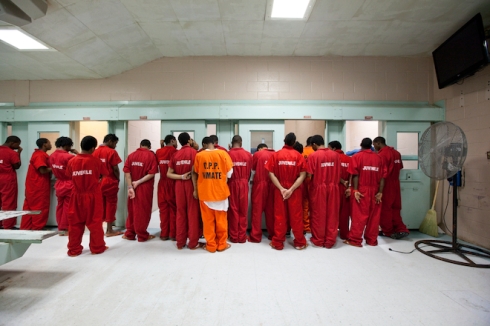

Richard Ross’ Juvenile-In-Justice project of photography and advocacy just keeps on rolling. And it does so with an experimental spirit and real world change.
Juvenile-In-Justice is currently on show at the Ice Box Project Space, part of Crane Arts in Philadelphia. Ice Box — which is in Kensington, one of Philadelphia’s poorest neighbourhoods — will host a free juvenile record expungement clinic on December 3rd.
The expungement clinic — which will be the first of its kind in Pennsylvania — expects to help 150 youth but there is no cut off. “We are going to take all we can and make sure no one is turned away,” says Ross.
Expungement is feasibly open to all youth but the expensive bureaucracy often prevents their ability to move into adulthood without criminal record they acquired as juveniles.
“If not expunged, a juvenile record is often a significant roadblock to employment and other opportunities for these young people. Even when someone takes action to expunge their record, hiring a private lawyer can cost thousands of dollars,” says Ross.
The show demonstrates a laudable cohesion of art and social practice.
“So often art that speaks to social justice issues is simply looked at, provoking brief contemplation among the audience,” says Ross. “While awareness is certainly great, we are turning the gallery into a laboratory for social change: photographic evidence of a problem hangs on the walls, while the people among the art work to alleviate it.”

The expungement clinic is particularly needed in Pennsylvania, state which is bucking the national and effective trends of youth decarceration.
“Pennsylvania is one of only two states in which the incarcerated juvenile population is actually growing,” says Ross.
Ross is quick to point out that this bold project comes about through the efforts of many partner organizations fighting for youth justice in the Philadelphia area, not least inLiquid Art + Design. “Their work, from inception to impact, is truly admirable,” says Ross.
Why should we care about juvenile incarceration? Check out my WIRED article about Ross’ work for some answers. Below, are a few more of Ross’ photographs from Juvenile-In-Justice.

Restraint chair for self-abusive juveniles at the Mendota Juvenile Treatment Center in Madison, WI houses 29 children and is usually at full capacity. The average stay for the emotionally and mentally disturbed juveniles, some of which are self-abusive or suicidal, is eight months. Children must be released at age 18, sometimes with no transition options available to them.

Nevada Youth Training Facility, Elko, NV.

“Time out room” at the South Bend Juvenile Correctional Facility, South Bend, IN.

“I photographed intake moments before a director of Los Padrinos Juvenile Hall, Downey, CA, had the juveniles sit in erect and proper on the benches – an unnatural positions. This is one of three major centers of the Los Angeles Juvenile confinement system, collectively the largest in the country. The great majority here is populated by Hispanic and African-American juveniles,” says Ross.

The air-conditioning was not working when Ross visited the Orleans Parish Prison (OPP) in New Orleans. There had also been a fight the previous night and as a result, TV, cards and dominoes privileges had been taken away. The OPP, managed by Sheriff Marlin Gusman, houses about 23 juvenile boys. They live two to each cell. The cells at their narrowest measure six feet in width.

Challenge Program, El Paso, TX. “They come in once a day and do a search of my room,” says the 14 Year old girl. “Everything I have in there, EVERYTHING, goes out–including the inside of the mattress and a body search–once a day. It happens anytime. Random. I was arrested for assault against a 13-year-old girl. It’s sort of all right, but it also really sucks. I’m here for Violation of Probation. I was at home with an ankle bracelet. I got mad at my mother and started throwing chairs and cut my ankle bracelet. My Mother works for Rody One industries; my Father lives in Juarez. I just finished starting 8th grade. It’s boring but I like to write poems, and listen to music. One day I might want to work as a Corrections Officer in a prison.”


1 comment
Comments feed for this article
January 19, 2014 at 6:33 pm
‘Voices Of Incarceration’ Exhibition Opens Saturday 25th in Los Angeles | Prison Photography
[…] last note — it’s great to see in the mix Prison Photography favourites Alyse Emdur, Richard Ross, Michal Chelbin and Sheila […]